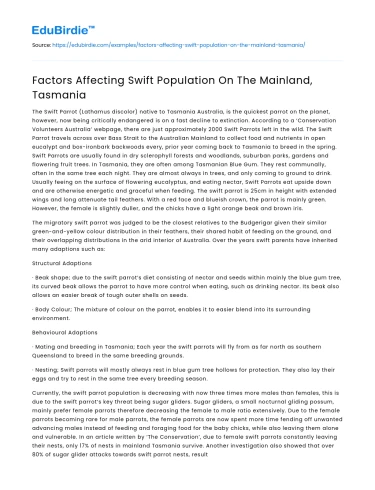The Swift Parrot (Lathamus discolor) native to Tasmania Australia, is the quickest parrot on the planet, however, now being critically endangered is on a fast decline to extinction. According to a ‘Conservation Volunteers Australia’ webpage, there are just approximately 2000 Swift Parrots left in the wild. The Swift Parrot travels across over Bass Strait to the Australian Mainland to collect food and nutrients in open eucalypt and box-ironbark backwoods every, prior year coming back to Tasmania to breed in the spring. Swift Parrots are usually found in dry sclerophyll forests and woodlands, suburban parks, gardens and flowering fruit trees. In Tasmania, they are often among Tasmanian Blue Gum. They rest communally, often in the same tree each night. They are almost always in trees, and only coming to ground to drink. Usually feeing on the surface of flowering eucalyptus, and eating nectar, Swift Parrots eat upside down and are otherwise energetic and graceful when feeding. The swift parrot is 25cm in height with extended wings and long attenuate tail feathers. With a red face and blueish crown, the parrot is mainly green. However, the female is slightly duller, and the chicks have a light orange beak and brown iris.
The migratory swift parrot was judged to be the closest relatives to the Budgerigar given their similar green-and-yellow colour distribution in their feathers, their shared habit of feeding on the ground, and their overlapping distributions in the arid interior of Australia. Over the years swift parents have inherited many adaptions such as:
Save your time!
We can take care of your essay
- Proper editing and formatting
- Free revision, title page, and bibliography
- Flexible prices and money-back guarantee
Structural Adaptions
· Beak shape; due to the swift parrot’s diet consisting of nectar and seeds within mainly the blue gum tree, its curved beak allows the parrot to have more control when eating, such as drinking nectar. Its beak also allows an easier break of tough outer shells on seeds.
· Body Colour; The mixture of colour on the parrot, enables it to easier blend into its surrounding environment.
Behavioural Adaptions
· Mating and breeding in Tasmania; Each year the swift parrots will fly from as far north as southern Queensland to breed in the same breeding grounds.
· Nesting; Swift parrots will mostly always rest in blue gum tree hollows for protection. They also lay their eggs and try to rest in the same tree every breeding season.
Currently, the swift parrot population is decreasing with now three times more males than females, this is due to the swift parrot’s key threat being sugar gliders. Sugar gliders, a small nocturnal gliding possum, mainly prefer female parrots therefore decreasing the female to male ratio extensively. Due to the female parrots becoming rare for male parrots, the female parrots are now spent more time fending off unwanted advancing males instead of feeding and foraging food for the baby chicks, while also leaving them alone and vulnerable. In an article written by ‘The Conservation’, due to female swift parrots constantly leaving their nests, only 17% of nests in mainland Tasmania survive. Another investigation also showed that over 80% of sugar glider attacks towards swift parrot nests, result in the death of the adult female parrot and her eggs. It has been recently recorded that sugar gliders have been reported at all regions where swift parrots breed within mainland Tasmania.
However, predation of the sugar gliders is just an effect of a bigger problem. In mainland Tasmania it has been shown that the reason there has been a growth of sugar glider population near swift parrots is because of the little forest cover that is left. Where forest cover had been abundantly lessened by farming, deforestation, and housing development, swift parrot nest has been shown to endure 100% predation rates. As a result of the continuing deforestation, the ‘ICUN red list’, predicts that the population of swift parrots due to sugar gliders predation, is predicted to decline by 94.7% in over three generations. The best-case situation-other probable causes of impermanence have not been included, such as habitat loss and collisions with man-made constructions. Sugar Gliders predation is likely to be so serious that even effective offshore island predator-free breeding will not be sufficient to avoid a decrease in the general population. Unless there is a drastic change into managing human impacts on the forests where swift parrots breed and a better understanding on how landscape scale forest loss impacts sugar gliders, and what conditions swift parrots need to survive, the swift parrot will become ‘extinct by 2037’.






 Stuck on your essay?
Stuck on your essay?

